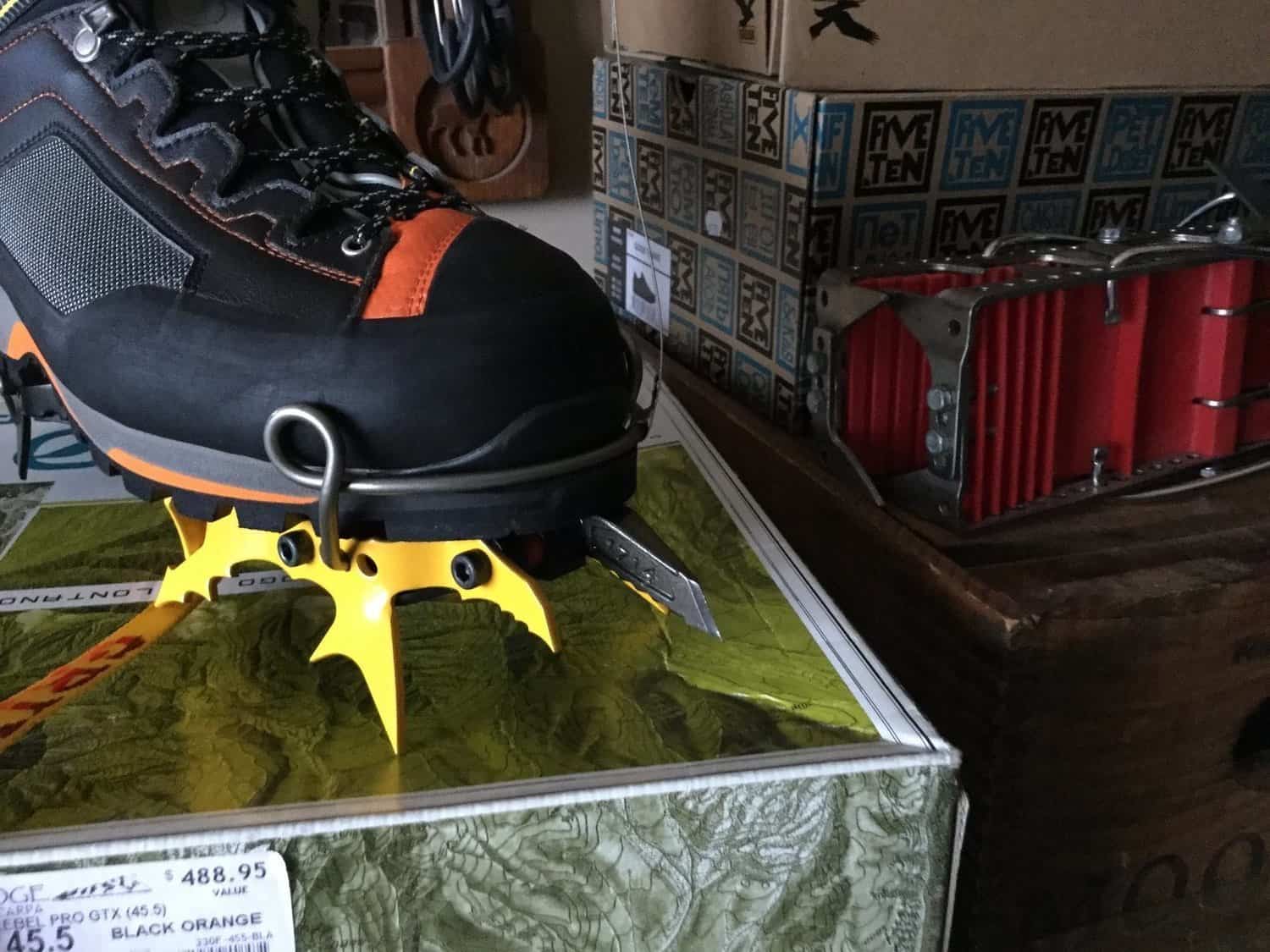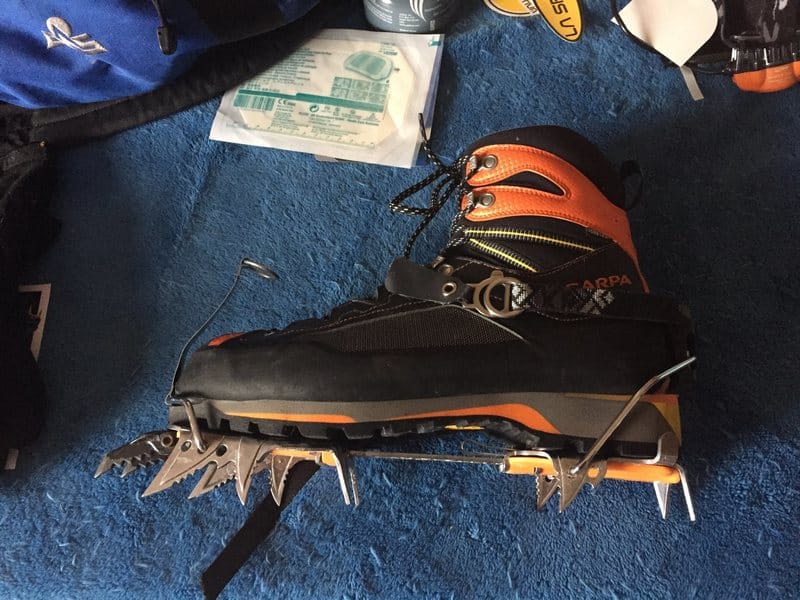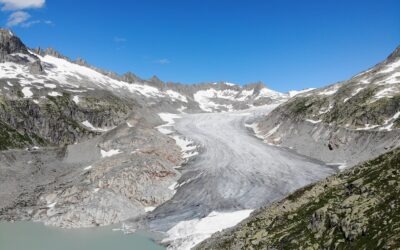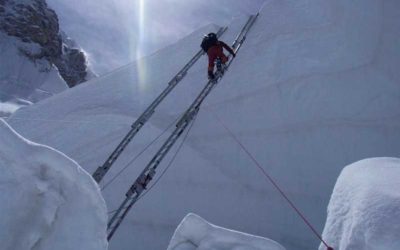
Hiking can entail walking up a gentle slope for long stretches and may or may not include technical or difficult terrain. Mountaineering, on the other hand, tends to be technical, difficult and intense.
So, can you use the same pair of boots for both hiking and mountaineering? In many cases the answer is yes. Hiking boots, if well suited for you can work on many mountains unless there are some technical climbing elements that require boots with specific attributes for ice climbing or deep snow.
For instance, I might be taking on a route that has a long, easy approach where I definitely only need hiking boots, followed by a difficult, highly technical portion where mountaineering boots are the most logical and safest option. Do I have to lug an extra pair of boots along for this, or can I use the same pair of boots for both?
In this article, I aim to answer that question in detail, exploring the pros and cons, along with specific attributes of each.
Attributes
Crampon Compatibility
This is crucial if you’re doing cold-weather trekking in glacier country. If you need to occasionally traverse some serious snow and ice, your boots definitely need to be compatible to crampons. This requires a stiffer boot with a more rigid sole, which enables a nice snug fit for your crampons.
Traditional boots meant for crampons have a groove around the toe of the boot, enabling a proper fit for the old-school crampons.
Modern crampons often have straps, though, making the toe groove obsolete. This means that some hiking boots are compatible with this type of crampon.
If you’re a beginner on a budget
My recommendation if you are on a budget and are just starting out would be to try finding a pair of beginner crampons that fit to your hiking boots. In many cases they will work sufficiently well, at least for traversing low angle ice and snow.
If you have some money and you are unsure of the difficulty of a route with a lot of snow, rather opt for a mountaineering boot, which will definitely be crampon compatible and would enable you to do some low angle ice climbing.
Sole Stiffness and the trade off
Hiking boots don’t have as stiff a shank as mountaineering boots. When using hiking boots, you have more flexibility for your foot. On the other hand, mountaineering boots, with their stiffer sole, would support ice climbing with crampons.
Here, you would have to trade off the comfort of hiking boots with the increased support for technical areas that you would get from mountaineering boots.
Ankle Support
Ankle support is critical, since a sprained ankle could put you in a very precarious position on a trek.
Luckily, all mountaineering and hiking boots offer ankle support, although some offer more than others. Mountaineering boots generally have a stiffer support structure around the ankle.
Weight difference
Generally, mountaineering boots are heavier than hiking boots, thus you’ll get tired more quickly when using mountaineering boots.
Mountaineering boots are stiffer and are made with extra layers, of which some could be plastic, that the average hiking boot doesn’t have. There are some lightweight mountaineering boots on the market, though.
Are mountaineering boots warmer?
Mountaineering boots generally have more insulation than hiking boots. Some mountaineering boots even have an inner, removable boot, which would keep your feet extra warm, especially if you’re planning to spend nights out in cold conditions.
Hiking boots generally don’t have extra insulation, so they’re not a good fit for spending nights out in cold conditions.

A classic Scarpa Mountaineer boot with crampons attached. Much stiffer than most hiking boots.
Pros and Cons of each
Mountaineering boots, especially the plastic ones, aren’t very comfortable to walk in for long stretches.
Even though technology and design have come a long way to improve the comfort of these boots, they’re stiffer and heavier than their hiking counterparts. When tied up incorrectly, mountaineering boots could seriously hurt your feet while hiking.
If your planned route is likely to involve a lot of frontpointing, rock climbing or kicking in steps to walk up, the heavier duty mountaineering boots would definitely be a win. These offer way more support than your average hiking boot and would protect your feet much better.
On the other hand, hiking boots are generally not suited for technical ice climbing and usually won’t keep your feet warm enough in winter.
You’ll have to weigh up the trade-off between carrying an extra pair of boots with you, versus trekking for long stretches in comparatively uncomfortable footwear.
There are some boots on the market that offer a more comfortable hike and that’s still suitable for ice climbing. These are quite expensive, though, so you have to be really sure that you want them and need those before you make the investment.
Conclusion
The short answer to the question, are mountaineering boots good for hiking, is, unfortunately, not that clear cut.
Mountaineering boots are generally not as comfortable as hiking boots, but will usually suffice on shorter routes where you plan to do some ice climbing in any case.
If you’re planning to do some hiking in warmer weather, mountaineering boots are definitely not recommended. You’ll sweat a lot and be super uncomfortable in your clunky boots, so you probably won’t enjoy the trip.
Written by Felix
April 25, 2019

About me
Hi! I’m Felix. When I’m not spending time out in the mountains, I like to write about my hobbies. That is how Mountain Homies was created. On this site, I try to gather all the juicy information about Mountaineering that I have learned since I started. Happy adventures!
Recent Posts
The 10 Largest Glaciers In The World (Length, Location & More)
In this article, we’ll have a look at the ten most massive glaciers in the world (by length, not area). Some of these are accessible for hiking and climbing, while others are not…
3 Ways to Spot and Reveal a Crevasse (And Avoid It)
So, how do you spot a crevasse and – more importantly – avoid falling into one? In this article, I will have a look at what crevasses are and how to detect them…
3 Clever Ways of Crossing A Crevasse
When you’re mountaineering in snow country, you will undoubtedly encounter some crevasses. These are scary, since you don’t always spot them…
Related Articles
3 Ways to Spot and Reveal a Crevasse (And Avoid It)
So, how do you spot a crevasse and – more importantly – avoid falling into one? In this article, I will have a look at what crevasses are and how to detect them…
3 Clever Ways of Crossing A Crevasse
When you’re mountaineering in snow country, you will undoubtedly encounter some crevasses. These are scary, since you don’t always spot them…
Mountain Climbing vs Rock Climbing: 5 Biggest Differences
The key differences between rock climbing and mountain climbing are the gear requirements, environmental risk, geographical locations, weather and…
Stay Up to Date With The Latest News & Updates
Join Our Newsletter
The owner of this site is a participant in the Amazon Services LLC Associates Program, an affiliate advertising program designed to provide a means for sites to earn advertising fees by advertising and linking to amazon.com.




